Barry's TV Cabinet
Repaired by Scott Mitchell

Barry has lots to say about his television. Purchased by his parents in 1977, it was one of the first TVs manufactured for colour transmission; it had a remote control and was set-up for a video connection (something that Barry couldn’t comprehend at the time of purchase). The ‘tele’ was the dominant feature of his parents’ lounge room and he saw it as an object that brought the family together. Each night the family would sit in their respective chair with their dinner in their lap and enjoy the evening programs together. Barry was a latchkey child, and reminisces about afternoons alone in the house in front of the TV with shows like ‘Mister Ed’ and ‘Twilight Zone’ sparking his imagination. The TV had a series of levers on the front, one for contrast, one for brightness and one for colour. He recalls many arguments over the colour. Is it too pink? Is it too blue? In the early 2000s Barry moved the TV out to his back shed, not because it was broken but because it had become obsolete – a remnant of the defunct analogue broadcast system. He covered it in plastic and put the legs on bricks to prevent damage from the damp.
Scott Mitchell has transformed Barry’s TV from a receiver of free-to-air transmission into a transmitter that echoes back electrical signals from an earlier time, repopulating the analogue air-waves once more, albeit on a very local level. Any screen that still supports analogue reception may tune into this transmission and experience Australian TV as it was in 1977. The original TV control panel is functional – here the channel selection can be made, and the volume and colour adjusted.
Design Repairer: Scott Mitchell
Scott holds an honours degree in Fine Art (Sculpture) and a PhD in Design. His art and design practice investigates the social nature of objects with specific focus on modes of amateur production. This field is explored through projects that engage existing communities and emergent, online practices. Scott’s research seeks to understand the significant role material processes play in forming communities and in developing shared meaning structures. Previous projects have engaged with practices of creative consumption (hacking and modding), amateur radio broadcasting, solar tracking and the generation of giant smoke rings. Scott’s projects adopt an open source attitude to knowledge production, the projects often build upon existing DIY practices and feed back into these amateur communities through the sharing of construction methods and build narratives.
Explore Object Therapy here
Barry’s TV Cabinet. Repaired by Scott Mitchell. Photos by Lee Grant. Image copyright Hotel Hotel.

